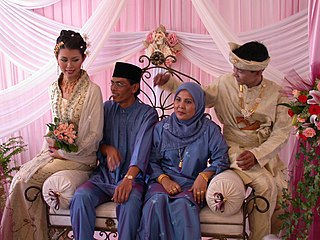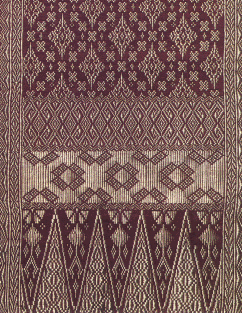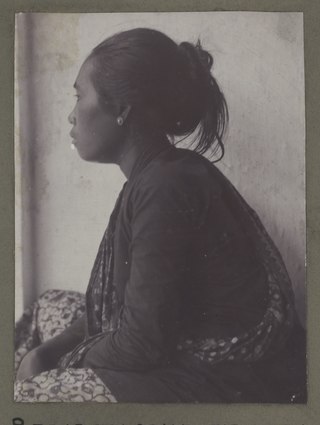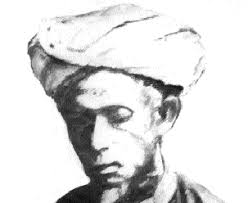
Malay is an Austronesian language that is an official language of Brunei, Indonesia, Malaysia, and Singapore, and that is also spoken in East Timor and parts of Thailand. Altogether, it is spoken by 290 million people across Maritime Southeast Asia.

Minangkabau people, also known as Minang, are an Austronesian ethnic group native to the Minangkabau Highlands of West Sumatra, Indonesia. The Minangkabau's West Sumatran homelands was the seat of the Pagaruyung Kingdom, believed by early historians to have been the cradle of the Malay race, and the location of the Padri War.

Riau is a province of Indonesia. It is located on the central eastern coast of Sumatra along the Strait of Malacca. The province shares land borders with North Sumatra to the northwest, West Sumatra to the west, and Jambi to the south, and a maritime border with the Riau Islands and the country of Malaysia to the east. It is the second-largest province in the island of Sumatra after South Sumatra, and is slightly larger than Jordan. According to the 2020 census, Riau had a population of 6,394,087 across a land area of 89,935.90 square kilometres; the official estimate as at mid 2022 was 6,614,384. The province comprises ten regencies and two cities, with Pekanbaru serving as the capital and largest city.

West Sumatra is a province of Indonesia. It is on the west coast of the island of Sumatra and includes the Mentawai Islands off that coast. West Sumatra borders the Indian Ocean to the west, as well as the provinces of North Sumatra to the north, Riau to the northeast, Jambi to the southeast, and Bengkulu to the south. The province has an area of 42,119.54 km2 (16,262.45 sq mi), with a population of 5,534,472 at the 2020 census. The official estimate at mid 2022 was 5,640,629. The province is subdivided into twelve regencies and seven cities. It has relatively more cities than other provinces outside Java, although several of them are relatively low in population compared with cities elsewhere in Indonesia. Padang is the province's capital and largest city.

The Riau Islands is a province of Indonesia - not to be confused with neighbouring Riau Province from which the islands were separated in 2002. The capital of the province is Tanjung Pinang and the largest city is Batam. It shares a maritime border with Riau and Jambi to the east, Bangka Belitung Islands to the south, Singapore to the northeast, Malaysia and West Kalimantan to the west, and Vietnam and Cambodia to the north.It comprises a total of 1,796 islands scattered between Sumatra, Malay Peninsula, and Borneo including the Riau Archipelago. Situated on one of the world's busiest shipping lanes along the Malacca Strait and the Natuna Sea, the province shares water borders with neighboring countries such as Singapore, Malaysia, and Brunei. The Riau Islands also have relatively large potential mineral resources and energy, as well as marine resources.

Jawi is a writing system used for writing several languages of Southeast Asia, such as Acehnese, Banjarese, Kerinci, Maguindanaon, Malay, Mëranaw, Minangkabau, Tausūg, and Ternate. Jawi is based on the Arabic script, consisting of all of the original 31 Arabic letters, and six additional letters constructed to fit the phonemes native to Malay, and an additional phoneme used in foreign loanwords, but not found in Classical Arabic, which are ca, nga, pa, ga, va, and nya.

Malay Singaporeans are an umbrella term for the indigenous ethnic groups of Maritime Southeast Asia-origin who adhered to the religion of Islam and settled in Singapore. The Singaporean Malays constitute approximately 13.5% of the country's citizens, making them the second largest ethnic group in Singapore. Under the Constitution of Singapore, they are recognised by the government as the indigenous people of the country, with Malay as the ethnosocial language.

Songket or sungkit is a tenun fabric that belongs to the brocade family of textiles of Indonesia, Malaysia, Brunei, and Singapore. It is hand-woven in silk or cotton, and intricately patterned with gold or silver threads. The metallic threads stand out against the background cloth to create a shimmering effect. In the weaving process the metallic threads are inserted in between the silk or cotton weft (latitudinal) threads in a technique called supplementary weft weaving technique.

The Bawean, or Baweans, or also Baweanese, also called Bawean Madurese are an ethnic group native to the island of Bawean, located in the Java Sea off the coast of Java, Indonesia. They are considered a distinct ethnic group within the larger Javanese cultural sphere. The Bawean people have their own unique language, also called Bawean, which belongs to the Austronesian language family.

Malay was first used in the first millennia known as Old Malay, a part of the Austronesian language family. Over a period of two millennia, Malay has undergone various stages of development that derived from different layers of foreign influences through international trade, religious expansion, colonisation and developments of new socio-political trends. The oldest form of Malay is descended from the Proto-Malayo-Polynesian language spoken by the earliest Austronesian settlers in Southeast Asia. This form would later evolve into Old Malay when Indian cultures and religions began penetrating the region, most probably using the Kawi and Rencong scripts, some linguistic researchers say. Old Malay contained some terms that exist today, but are unintelligible to modern speakers, while the modern language is already largely recognisable in written Classical Malay of 1303 CE.

Kuantan Singingi is a regency (kabupaten) of Riau, Indonesia. It is located on the island of Sumatra. The regency was created on 4 October 1999 from what had been the western half of Indragiri Hulu Regency. It has an area of 7,656.03 km² and had a population of 292,116 at the 2010 Census and 334,943 at the 2020 Census; the official estimate as at mid 2022 was 345,850. The seat of the regency is the town of Teluk Kuantan.

Malay Indonesians are ethnic Malays living throughout Indonesia. They are one of the indigenous peoples of the country. Indonesian, the national language of Indonesia, is a standardized form of Riau Malay. There were numerous kingdoms associated with the Indonesian Malays along with other ethnicities in what is now Indonesia, mainly on the islands of Borneo and Sumatra. These included Srivijaya, the Melayu Kingdom, Dharmasraya, the Sultanate of Deli, the Sultanate of Siak Sri Indrapura, the Riau-Lingga Sultanate, the Sultanate of Bulungan, Pontianak Sultanate, and the Sultanate of Sambas. The 2010 census states that there are 8 million Malays in Indonesia; this number comes from the classification of Malays in East Sumatra and the coast of Kalimantan which is recognized by the Indonesian government. This classification is different from the Malaysia and Singapore census which includes all ethnic Muslims from the Indonesian archipelago as Malays.
The Duano' people, also called Desin Dolak or Desin Duano' are an indigenous people of Malaysia and Indonesia and can be found in islands along the northeastern region of Sumatra, Indonesia where most Duano' people have traditionally lived. They are one of the Proto-Malay group of cultures. Due to their nomadic boat lifestyle, based almost exclusively on fishing and collecting shellfish and crustaceans by using mud-boards, Duano' people are often categorized as Orang Laut, a group that includes the Urak Lawoi’ people and Moken people of the northern region of the Malacca Strait and the Andaman Sea. Although there are similarities in their way of life, they are a separate ethnic group. Citing their own language, culture, identity, and economic complexities, they deny being Orang Laut.

Raja Ali Haji was a 19th-century (1808–1873) Penyengat-born Bugis Muslim historian, poet, scholar, and ulama. He was elevated to the status of National Hero of Indonesia in 2004. His notable works also are recognised as Intangible Cultural Heritage by the Indonesian Ministry of Education and Culture. He is also well-known with his status as the ‘Father of Indonesian language’ due to his great influence in Indonesian linguistic development.

Sembah is an Indonesian greeting and gesture of respect and reverence. While performing the sembah, one clasps their palms together solemnly in a prayer-like fashion called suhun or susuhun in Javanese; or menyusun jari sepuluh in Indonesian and Malay, placing them in front of their chest and moving the pressed palms up to their chin, or all the way up until their thumbs touch the tip of their nose, while bowing slightly. Any of these two forms are made depending on the status of the person greeted.

The Kampar River is on the island of Sumatra in Indonesia, about 800 km northwest of the capital Jakarta. It is a well-known river surfing destination because of its tidal bore, known as Bono.

Riau Malays is a Malays sub-ethnic originating from the Riau and Riau Islands province. The main areas of the Riau Malays are on the east coast of Riau, mostly in Bengkalis, Indragiri Hulu, Kampar, and the Pekanbaru City area which was the base of the Malay Kingdom in the past. The Riau Malays are famous for Riau Malay Literature which is well applied in rhymes, syair, gurindam, hikayat, karmina, seloka, traditional poems, local proverbs, mantras, and romance stories, as well as other forms of expression which they use to express their feelings.

The pacu jawi is a traditional bull race in Tanah Datar, West Sumatra, Indonesia. In the race, a jockey stands on a wooden plough loosely tied to a pair of bulls and holds them by their tails while the bulls cover about 60–250 metres (200–820 ft) of muddy track in a rice field. Although the name means a "bull race", the bulls do not directly compete against each other, and no formal winner is declared. Instead, spectators judge the bulls by their performance, and have the ability to buy well-performing bulls, albeit at well above usual price. The people of Tanah Datar—especially the nagaris (villages) in four of its districts—have been conducting this tradition for centuries to celebrate the end of the rice harvest. The race is held concurrently with a village festival of culture called alek pacu jawi. Recently it has become a tourist attraction supported by the government and the subject of multiple award-winning photographs.

Intan Aletrinö is an Indonesian actress, television presenter, and supermodel, who is National Narcotics Board of the Republic of Indonesia Ambassador. She won the title of Puteri Indonesia Pariwisata 2016. She represented Indonesia at the Miss Supranational 2016 pageant in Krynica-Zdrój, Poland, where she placed in the top 10, also won Miss Elegance and Miss Multimedia Awards. She is the great-granddaughter of Dutch physician Arnold Aletrino.

Minangkabau culture is the culture of the Minangkabau ethnic group in Indonesia, part of the Indonesian culture. This culture is one of the two major cultures in the Indonesian archipelago which is very prominent and influential.





















